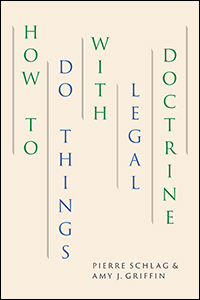How to do things with legal doctrine
- ISBN: 9780226726243
- Editorial: University of Chicago Press
- Fecha de la edición: 2020
- Lugar de la edición: Chicago. Estados Unidos de Norteamérica
- Encuadernación: Rústica
- Medidas: 23 cm
- Nº Pág.: 207
- Idiomas: Inglés

Legal doctrine—the creation of doctrinal concepts, arguments, and legal regimes built on the foundation of written law—is the currency of contemporary law. Yet law students, lawyers, and judges often take doctrine for granted, without asking even the most basic questions. How to Do Things with Legal Doctrine is a sweeping and original study that focuses on how to understand legal doctrine via a hands-on approach. Taking up the provocative invitations from the “New Doctrinalists,” Pierre Schlag and Amy J. Griffin refine the conceptual and rhetorical operations legal professionals perform with doctrine—focusing especially on those difficult moments where law seems to run out, but legal argument must go on. The authors make the crucial operations of doctrine explicit, revealing how they work, and how they shape the law that emerges. How to Do Things with Legal Doctrine will help all those studying or working with law to gain a more systematic understanding of the doctrinal moves many of our best lawyers make intuitively.
Chapter One: What Is Doctrine?
I. The Big Picture
A. Artifacts
B. Sources of Law
C. Functions
1. Structuration
2. Defusing, Resolving, or Extinguishing Conflict
3. Correction
4. Realization of the Legal System
5. Reflexivity
D. Legal Elements
1. Legal Persons
2. Entitlements and Disablements
3. Attribution Rules
4. Transfer Mechanisms
5. Interests/Harms
6. Remedies
II. Doctrine
A. The Characteristics of Doctrine
B. The Structured Elasticity of Doctrine
III. The Itinerary
Chapter Two: Frames and Framing
I. Entry-Framing
II. Broad vs. Narrow Time Frames
III. Segmented vs. Continuous Transactions
IV. Action vs. Omission
V. Level of Abstraction
VI. The Theater Metaphor
VII. Exit-Framing
Chapter Three: Baselines
I. Baseline Selection Problems
A. Classic Baselines
B. Variations within a Single Baseline
1. Level of Abstraction
2. Individualization
3. Multiplicity
II. Baseline Neutrality Problems
A. Failed Neutrality
B. Denial and Evasion
III. Baseline Collapse Problems
IV. Summary
Chapter Four: The Legal Distinction
I. What Do Legal Distinctions Do?
II. Three Criteria for “Sound” Legal Distinctions
A. Conceptual Intelligibility
B. Practicality
C. Normative Appeal
III. The Trade-Offs among the Three Criteria
IV. The Classic Flaws and Why They Matter
A. The Classic Flaws
1. Overbreadth
2. Underbreadth
3. Overlap
4. Discontinuity
5. False Dichotomy
6. Incoherence
7. Vagueness
B. Why the Classic Flaws Matter: From Form to Substance
1. Waste
2. Fairness/Equality
3. Subversion
4. Efficiency
5. Rule of Law
VI. Crafting Legal Distinctions
VII. Where Do You Draw the Line?
A. The Non-ideal World and the Inevitable Trade-Offs
B. Arbitrariness
C. Indivisibilities
D. Dynamic Fields
E. Problem Fields and Non-fields: Of Polycentricity and Flux
F. The Slippery Slope
VIII. The Fetishism of the Legal Distinction
Chapter Five: Rules and Standards
I. Defining Rules and Standards
II. The Rules vs. Standards Dialectic
A. Deterrence
B. Delegation
C. Communication/Formalities/Notice
III. The Substantialized Versions of the Dialectic
IV. The Limitations of the Dialectic
A. Of Vices and Virtues
B. The Polycentricity Challenge
C. The Epistemological Twist
V. The Irreducibility of the Dialectic
Chapter Six: Resolving Regime Conflicts
I. Techniques
A. Hierarchy
B. Sectorization
C. Policy Judgment
D. Balancing
E. Meta-quantification Approaches
F. Conflict Prevention Approaches
G. Referral/Deference/Denial
H. Channeling
II. Putting It Together
A. Hybrids
B. Entailments
C. Summary
Chapter Seven: Interpretation
I. The Interpretive Situation: Recurrent Tensions and Conflicts
A. The “Legal” in the Legal Text
B. The Interpretive Contexts
1. Fact-Rich
2. Institutionally Localized
3. Procedural Posture
4. Discernible Specific Consequences
C. The Textual Feedback Loop
D. The Plurality of Contexts
1. The Context of Application
2. The Authorial Context
3. The Addressee Context
4. The Functional Legal Context
5. Contexts Generally
E. Fidelity to the Original Meaning
F. Summary
II. Textualism
A. Individuation: What Is the Unit of Interpretation?
B. Intratextual Integrity
C. Intertextual Integrity
III. Purposivism
A. Multiple Purposes
B. Selection
C. The Structure of Purpose
IV. Summary
Chapter Eight: Cluster Logic
I. A Cautionary Note
II. The Structural Distinction Clusters
III. How the Clusters Matter
A. The Clusters as Classic Options
B. Nuance: Substituting One Distinction or One Term for Another
C. Cluster Functions
1. Function Tags for the Choice/Coercion Cluster
2. Function Tags for the Public/Private Cluster
IV. Operationalizing the Clusters: Interaction
A. Combining Clusters
B. The Theatrical Metaphor
V. The Logic of Dissociation
A. Chaining: Running an Argument through Successive Clusters
B. Cluster Alliances
VI. Cluster Logic






